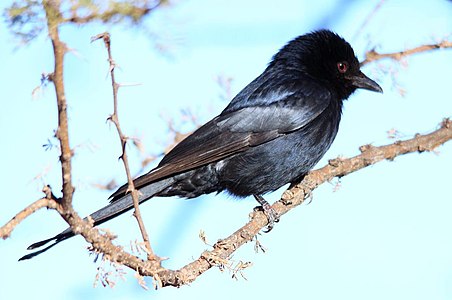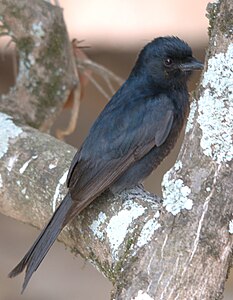Fork-tailed drongo
| Fork-tailed drongo | |
|---|---|

| |
| D. a. fugax pictured in Rwanda, and song of nom. subspecies, South Africa | |
| Scientific classification | |
| Domain: | Eukaryota |
| Kingdom: | Animalia |
| Phylum: | Chordata |
| Class: | Aves |
| Order: | Passeriformes |
| Family: | Dicruridae |
| Genus: | Dicrurus |
| Species: | D. adsimilis
|
| Binomial name | |
| Dicrurus adsimilis (Bechstein, 1794)
| |
The fork-tailed drongo (Dicrurus adsimilis), also called the common drongo or African drongo, is a small bird found from the Sahel to South Africa that lives in wooded habitats, particularly woodlands and savannas. They are part of the family Dicruridae and have four recognized subspecies, D. a adsimilis, D. a. apivorus, D. a. fugax and D. a. jubaensis. Like other drongos, the fork-tailed is mostly insectivorous; its diet mainly consists of butterflies, termites, and grasshoppers.
Physically this species is characterized with a narrow fork-shaped tail, red-brownish eyes, and black plumage throughout all of its body. As an omnivorous species, its diet consists of small insects, composing of butterflies, grasshoppers and beetles, besides fruit, including those of Azadirachta indica and Moringa oleifera.
The fork-tailed drongo is known for its ability to deceptively mimic other bird alarm calls in order for a certain animal to flee the scene so it can steal their food (kleptoparasitism). They are also notorious for displaying an aggressive and fearless behaviour by attacking and chasing off much larger animals, including birds of prey, when their nest or young are threatened. Due to its extensive range and stable population, the fork-tailed drongo is classified by the IUCN Red List as a least-concern species.
Taxonomy
Described by Johann Matthäus Bechstein in 1794. Its populations are genetically highly structured,[2] and four races are accepted.[3][4] As of 2023, D. a. divaricatus and D. a. lugubris are included within the taxon by the IOC.[5] The races D. a. modestus (Príncipe) together with D. a. coracinus and D. a. atactus (Bioko to west and central mainland Africa, from Guinea east to western Kenya and south to Angola) are usually split as a separate species, the velvet-mantled drongo, D. modestus (Hartlaub, 1849).
- D. a. apivorus Clancey, 1976
- Range: Gabon, Congo Republic, DRC, Angola, northwestern Zambia, Namibia, Botswana and northwestern South Africa
- Description: primary remiges with brown outer vanes and pale inner vanes (noticeable while perched and in flight respectively)[4]
- Habitat: Arid savanna
- D. a. fugax W.K.H.Peters, 1868
- D. a. adsimilis (Bechstein, 1794)
- D. a. jubaensis van Someren, 1931
- Range: Ethiopia, Eritrea, and Somalia
- D. a. divaricatus (Lichtenstein, MHK, 1823) – Senegambia and south Mauritania to southwest Chad.[6]
- D. a. lugubris (Hemprich & Ehrenberg, 1828) – south Chad to Eritrea, Ethiopia, north Kenya, and north Somalia.[6]
Distribution and habitat
The fork-tailed drongo is a common and widespread resident breeder in Africa south of the Sahara. These insect-eating birds are usually found in open forests or bush, and are tolerant of arid climates. Its range was formerly considered to include Asia, but the Asian species is now called the black drongo (D. macrocercus).
Description
The fork-tailed drongo is small sized measuring 25 centimetres (9.8 in) long and weighing 50 grams. They have short legs, a wingspan of 134 mm. They have a bill depth of 0,4 mm and a bill length of 2.8 mm. Males are mainly glossy black, although their wings are duller. Females are similar but less glossy. It is large-headed with well-developed rictal and nasal bristles, which are used as sensory organs.[7] The rectrices curve outwards, forming the forked tail for which the species is named. The hooked bill is black and heavy, and the eye is red.
Calls
The call is a metallic strink-strink. The fork-tailed drongo uses alarm calls to steal food from birds and animals such as meerkats. They make drongo-specific calls as well as mimicked calls. The mimicked calls help them while they target other animals that are eating food. The animals flee and leave their food behind. Once they are gone, the drongo steals it.[8][9] Vocal at dawn and dusk.[3]
Behavior
They are usually solitary and form monogamous breeding pairs. They are aggressive and fearless, regularly mobbing or attacking much larger species, including birds of prey, if their nest or young are threatened or their territory is compromised.[7] They also join mixed foraging bird parties, and will initiate mobbing of common enemies.[7] To maintain their plumage condition they may rain-bathe, foliage-bathe or plunge-dive into water. Terrestrial foragers like babblers may use the drongo as a sentry.[7]
Feeding
This specie is mostly insectivorous and occasionally eats fishes and other birds, furthermore they may take nectar and eat plants when available too.[7][10] Predominant preyed animals are butterflies, beetles, caterpillars, grasshoppers, honey bees, moths, termites and weevils, especially common species being the angola white lady, macrotermes natalensis, cyrtacanthacris aeruginosa, and the desert locust. Sometimes they might also eat small fishes by swooping down from a perch hovering over water and dipping, it has been observed small birds being captured with their claws or bills, namely the bronze mannikin. Plants take around 15% of their diet, usually eaten are the moringa oleifera, azadirachta indica and the dialium guineense. This bird is solidarity in its hunting.[11][10] This species spends about 62% of the day feeding during the dry season, and 56% of the day during rainy seasons.[10]
Usually, the fork-tailed drongo perches, from a height of 5 m (16 ft 5 in) to 7 m (22 ft 11+1⁄2 in), in an erect pose from which they rapidly charge insects flycatching, plunge diving or grabbing it on the ground and then return to the same branch. They utilize disturbance caused by other animals in their hunting.[7] The specie can hold large items with their claws and tear them with their bills; removes wings of butterflies. In the Kalahari the fork-tailed is famous for their kleptoparasitism, they mimic other birds or use their own alarms to make other animals think that there're predators nearby and thus make them flee and leave their food behind so the fork-tailed can steal it. They frequent savanna fires, where they catch fleeing insects and other prey running from the flames.[11][10]
Kleptoparasitism
A common employed tactic by the fork-tailed drongo to get food is kleptoparasitism. The drongo will give genuine alarm calls to alert the presence of predators to other animals, but sometimes it will give a false alarm call to displace those animals and steal their food. Species, such as southern pied babblers, sociable weavers, white-browed sparrow-weavers, wattled starlings and cape starling, that forage on the ground are often are frequent victims of the fork-tailed kleptoparasitism, because according to a study the drongos don't possess the appropriate morphological adaptations to hunt certain preys that are more nutritious and calorific so they use kleptoparasitism.
It has been observed that fork-tailed drongos spend a quarter of their time following other animals. Though in doubt, researchers have considered the possibility that these drongos possess theory of mind, not fully shown in any animal other than humans.[9][12][13]
Breeding
Fork-tailed drongos breeding season can start as early as February and go until November and the number broods range from two to three. Drongos are commonly used as brood hosts for the African cuckoos (21.8% of nests), in the Kalahari Desert was found that Jacobin cuckoos also parasite the drongo.[14]
Drongo eggs have a wide diversity of colours and patterns as a form of personal signature, which the cuckoos imitate. Experiments suggest that the drongos can identify and reject 93.7% of introduced eggs.[15]
Conservation status
Due to their very large range, stable population trend and size, the fork-tailed drongo is considered to be a least-concern species by the IUCN Red List. Though the subspecie D. a. modestus, previously considered a separated specie, was considered a near-threatened. Major threats for the fork-tailed is the use of pesticides that reduces the availability of their prey and the destruction of habitat to create farmland.
Gallery
-
View of pronounced rictal and nasal bristles and the deep red eye
-
The western race D. a. apivorus has brown edges to the primaries and occurs in dry woodlands of southwestern Africa.
-
Eastern race D. a. fugax is somewhat smaller than the nominate.
-
Immature D. a. adsimilis with dusky primaries
References
- ^ BirdLife International (2016). "Dicrurus adsimilis". IUCN Red List of Threatened Species. 2016: e.T103710902A95034217. doi:10.2305/IUCN.UK.2016-3.RLTS.T103710902A95034217.en. Retrieved 19 November 2021.
- ^ Bowie, Rauri; Crowe, Tim; Voelker, Gary; et al. "Comparative phylogeography of southern African birds" (PDF). Annual Report January – December 2009, Research Programmes & Initiatives: Systematics and Biogeography. Percy FitzPatrick Institute, University of Cape Town. Retrieved 24 August 2016.
- ^ a b Rocamora, G.; Yeatman-Berthelot, D. (2016). "Fork-tailed Drongo (Dicrurus adsimilis)". Handbook of the Birds of the World Alive. Lynx Edicions, Barcelona. Retrieved 24 August 2016.
- ^ a b c d Chittenden, H.; et al. (2012). Roberts geographic variation of southern African birds. Cape Town: JVBBF. pp. 204–205. ISBN 978-1-920602-00-0.
- ^ "IOC Master List v13.2". IOC World Bird List.
- ^ a b Gill, Frank; Donsker, David; Rasmussen, Pam. "Species Updates – IOC World Bird List". www.worldbirdnames.org. International Ornithological Committee. Retrieved 2023-07-25.
- ^ a b c d e f Carnaby, Trevor (2008). Beat about the bush: Birds (1st ed.). Johannesburg: Jacana. pp. 572–573. ISBN 9781770092419.
- ^ Flower, Tom (May 22, 2011). "Fork-tailed drongos use deceptive mimicked alarm calls to steal food". Proceedings of the Royal Society B: Biological Sciences. 278 (1711): 1548–1555. doi:10.1098/rspb.2010.1932. PMC 3081750. PMID 21047861.
- ^ a b Flower, Tom (2010). "Fork-tailed drongos use deceptive mimicked alarm calls to steal food". Proceedings of the Royal Society B. 278 (1711): 1548–1555. doi:10.1098/rspb.2010.1932. PMC 3081750. PMID 21047861.
- ^ a b c d E.F., Okosodo; J.O., Orimaye; O.S, Odewumi (2016). "Diet and Foraging Ecology of Fork Tailed Drongo (Dicrurusadsimilis) in Leventis Foundation Nigeria, Agricultural School South West Nigeria" (PDF). International Journal of Environment, Agriculture and Biotechnology: 252–256. doi:10.22161/ijeab/1.2.20.
- ^ a b Rocamora, Gérard; Yeatman-Berthelot, Dosithée (2020). "Fork-tailed Drongo (Dicrurus adsimilis), version 1.0". Birds of the World. doi:10.2173/bow.fotdro5.01.
- ^ Yong, Ed (1 May 2014). "The Bird That Cries Wolf Changes Its Lies". National geographic. Retrieved 2 May 2014.
- ^ Flower, T. P. (2014). "Deception by Flexible Alarm Mimicry in an African Bird". Science. 344 (6183): 513–516. doi:10.1126/science.1249723. PMID 24786078. S2CID 3005286.(subscription required)
- ^ Flower, Tom (May 2015). "Dual parasitism of Fork-tailed Drongos by African and Jacobin Cuckoos". Ostrich. 86 (1–2): 189–191. doi:10.2989/00306525.2015.1029032. S2CID 84740346.
- ^ Cracking the great cuckoo cover-up, University of Cambridge
Further reading
- African Bird Club (2006) ABC African Checklist: Passerines. Accessed 16/01/08.
- Birds of The Gambia by Barlow, Wacher and Disley, ISBN 1-873403-32-1
- Sinclair, Ian & Ryan, Peter (2003) Birds of Africa south of the Sahara, Struik, Cape Town.
- Fuchs, J.; De Swardt, D.H.; Oatley, G.; Fjeldså, J.; Bowie, R.C.K. (2018). "Habitat- driven diversification, hybridization and cryptic diversity in the Fork- tailed Drongo (Passeriformes: Dicruridae: Dicrurus adsimilis)". Zoologica Scripta. 47 (3): 266–284. doi:10.1111/zsc.12274.
External links
- Fork-tailed Drongo - Species text in The Atlas of Southern African Birds.
- Fork-tailed drongo videos, photos & sounds on the Internet Bird Collection





